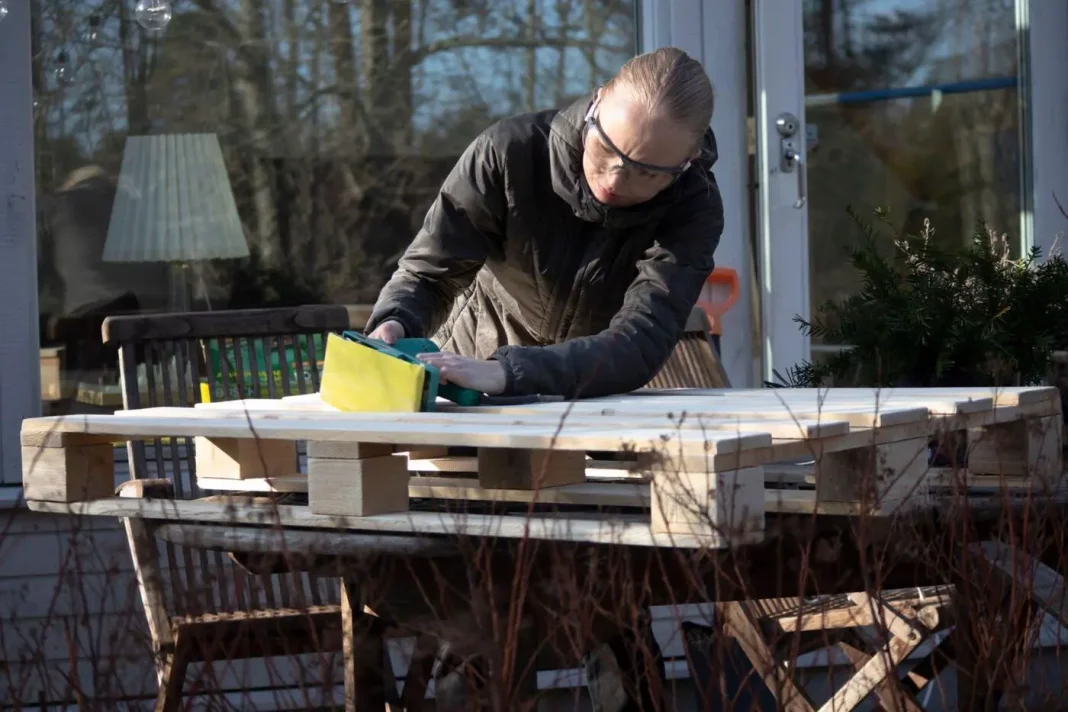Introduction: The Charm and Sustainability of Pallet Furniture
Hey, fellow DIY enthusiasts! Imagine creating a stylish wooden coffee table or a quirky bookshelf without splurging too much. Exciting, right? Pallet furniture is making waves in the DIY community for being both trendy and eco-friendly. Whether you’re an experienced crafter or just beginning, there’s something incredibly satisfying about transforming a humble pallet into a functional masterpiece. Join us as we delve deeper!
Sourcing the Perfect Pallet: Your Comprehensive Guide to Quality Wood
1. Scouting the Best Locations: Where to Begin Your Hunt
To craft that perfect piece of furniture, it’s essential to start with the right raw material. Pallets are available in numerous places if you know where to look:
- Warehouses and Stores: Both big retail chains and smaller local stores often find themselves with a surplus of pallets, primarily used for shipping. While some might have programs to return or recycle these, others might just be looking for ways to dispose of them. Always approach the management and ask for permission. Not only could you obtain pallets for free, but you’d also be helping them reduce waste.
- Online Platforms: In today’s digital age, numerous platforms can be a goldmine for sourcing pallets. Websites like Craigslist or Freecycle are community-driven platforms where individuals and businesses occasionally list free or inexpensively priced pallets. It’s essential, however, to act fast as these listings can be snapped up quickly.
- Recycling Centers: These centers are a hub for all things recyclable, including wood. Some centers specifically store pallets and offer them at minimal costs to interested individuals. As a bonus, choosing this route is environmentally friendly, ensuring that reusable resources are not wasted.
2. Deciphering Pallet Labels: Know What You’re Bringing Home
Pallets often come with markings or labels, which can give insight into their treatment and usability. Understanding these can ensure you choose the safest and most appropriate pallets for your project:
- EPAL: If you spot this marking, you’re in luck. EPAL indicates the pallet is part of the European Pallet Association and is safe for use. These pallets are treated without harmful chemicals, making them suitable for furniture crafting.
- Colored Pallets: While a brightly colored pallet might look appealing, it’s essential to be cautious. These are typically treated, and the coloring can be a result of a chemical process. For indoor furniture or projects where chemical treatments could pose risks, it’s best to avoid these.
3. Preparing and Cleaning Your Pallet: A Crucial Step
Once you’ve sourced your perfect pallet, the next step is to ensure it’s clean and safe for your DIY project:
- Inspect: Before anything else, give your pallet a thorough inspection. Check for protruding nails, signs of pests like termites, or any mold. Addressing these issues at the outset can save you a lot of trouble down the line.
- Wash: Over time, pallets can accumulate dirt, grime, and other contaminants. If you have access to a power washer, it can make the cleaning process a breeze. However, if you don’t, don’t fret. A sturdy brush, some soapy water, and a bit of elbow grease can be just as effective. Once cleaned, ensure the pallet is left to dry properly to prevent mold growth.
Designing Your Furniture: Transforming Vision into a Concrete Blueprint
1. Finding Inspiration: The Spark That Fuels Creation
Before you embark on your furniture crafting journey, it’s crucial to gather inspiration and decide on a design that resonates with you. The design phase is arguably as vital as the crafting phase because it lays the foundation for your entire project.
- Online Portals: In this digital age, there’s a wealth of inspiration available online. Websites like Pinterest are treasure troves of innovative pallet furniture ideas. By simply entering keywords or browsing through themed boards, you can find thousands of images showcasing unique designs. Similarly, dedicated DIY blogs often feature step-by-step guides, providing both inspiration and practical tips.
- DIY Workshops: For those who prefer a more hands-on approach, joining a local DIY workshop can be immensely beneficial. Not only will you get firsthand experience under the guidance of seasoned professionals, but you’ll also be exposed to fresh ideas and techniques that you might not have encountered online. Plus, being around fellow DIY enthusiasts can be incredibly motivating and enriching.
2. Drafting Your Masterpiece: The Blueprint of Success
Once you’ve gathered ample inspiration and have a vague idea in mind, it’s time to translate that vision into a tangible plan. Drafting is essential, as it helps avoid costly mistakes and ensures your project runs smoothly.
- Paper Sketch: The traditional method, but by no means outdated. Using simple tools like pencil, ruler, and eraser, sketch out your design on paper. Start with rough doodles, gradually refining them into detailed drawings. This process can help clarify dimensions, joint placements, and the overall look of your furniture piece. Remember, it doesn’t have to be perfect; it just needs to make sense to you (and anyone assisting you).
- Digital Tools: Technology has gifted us with a variety of software applications that can elevate the design process. Apps like SketchUp offer the ability to create detailed 3D visualizations of your furniture design. What’s great about such tools is their interactive nature. You can virtually “walk around” your design, tweak dimensions in real-time, and even add textures or colors to get a clearer picture of the finished product. While there might be a slight learning curve, the benefits are well worth the effort. Plus, many of these applications offer free versions or tutorials to get you started.
Crafting Your Masterpiece: An In-depth Guide to Pallet Furniture Creation
1. Disassembling the Pallet: The First Step
Before you can start creating, you need to break down your pallet into usable wood planks. This process can be tricky, but with the right tools and precautions, it’s a breeze.
- Safety First: When working with any wood, especially rough pallets, protecting your hands is paramount. Wearing gloves will shield you from splinters, nails, and sharp edges. Consider investing in heavy-duty gloves that offer both comfort and protection.
- Pallet Breaking Tool: While there are numerous methods to disassemble a pallet, having a specialized pallet breaking tool can significantly simplify the process. This tool is designed to provide leverage, making it easier to pry apart the planks without causing damage.
- Additional Tip: Remember to remove all nails from the planks. A magnetic sweeper can help ensure you don’t miss any stray nails.
2. Accurate Measurements: Precision is Key
Any seasoned carpenter will tell you – measure twice, cut once.
- Tape Measure: This tool is indispensable. Ensure you invest in a durable, high-quality tape measure that offers both metric and imperial readings. The clearer the markings, the better.
- Marking: A carpenter’s pencil is ideal for marking on wood. Its flat design ensures it doesn’t roll away, and its thick graphite core makes bold, clear marks that can easily be erased or sanded off later.
3. Sanding For Perfection: From Rough to Sleek
Sanding is crucial in achieving that smooth, professional finish, making the wood safer and more aesthetically pleasing.
- Types of Sandpaper: Not all sandpapers are created equal. Start with a coarse 60-grit paper to smooth out any major imperfections or rough spots. Gradually move to finer grits, finishing with a 220-grit for that ultra-smooth touch.
- Sanding Block: Wrapping your sandpaper around a sanding block ensures an even pressure, resulting in a more consistent finish. It also offers a better grip and reduces hand fatigue, especially during extensive sanding sessions.
4. Assembling: : Crafting Piece-by-Piece
This step is where your project truly starts to take shape.
- Drilling Pilot Holes: Before you directly screw or nail into the wood, it’s wise to drill pilot holes. These preliminary holes guide your screws and nails, reducing the risk of the wood splitting or cracking.
- Clamps: Clamps are like having an extra pair of hands. They hold pieces together, ensuring a tight fit and allowing you to work more efficiently. Depending on your project, you might need different clamp sizes and styles.
5. Finishing Touches: The Cherry on Top
Now that your furniture piece is assembled, it’s time to beautify and protect it.
- Choosing Stains: Water-based stains are not only eco-friendly but also user-friendly. They dry faster, clean up easily with water, and are available in a vast spectrum of colors. When choosing a shade, consider where your furniture will be placed and the overall décor of that space.
- Sealant: A good quality sealant acts as a shield against moisture, UV rays, and daily wear and tear. It’s particularly vital for outdoor furniture. There are various options available, including matte, satin, or glossy finishes. Choose one that complements your stain and desired look.
Care and Maintenance: Ensuring Longevity of Your Pallet Creations
1. Dusting Techniques: The First Line of Defense
Dust and debris can accumulate on your pallet furniture, especially given the rough and porous nature of untreated pallet wood. Regular dusting ensures that your furniture maintains its shine and doesn’t become a haven for allergens.
- Microfiber Cloth: This isn’t your ordinary cloth. The unique structure of microfiber materials means they can pick up and trap dust particles effectively, rather than merely spreading them around. It’s an excellent investment not just for your pallet furniture but all surfaces in your home.
- Dusting Brushes: For those intricate designs and hard-to-reach corners, consider a soft-bristled dusting brush. It can help sweep away dirt from crevices without scratching or damaging the wood.
- Damp Cloth Technique: Occasionally, using a lightly dampened cloth can help pick up stubborn dust or grime. Ensure you thoroughly dry the furniture afterward to prevent moisture damage.
2. Polishing Insights: Enhance and Protect
Over time, wood can lose its luster. Polishing not only helps in bringing back the sheen but also acts as a protective layer against minor spills and stains.
- Natural Polish: Commercial polishes may contain chemicals that can harm the environment and potentially degrade your pallet wood. A mixture of olive oil and lemon juice can be a game-changer. Olive oil acts as a natural conditioner, while the lemon juice helps clean and provide a pleasant aroma. Mix 2 parts olive oil with 1 part lemon juice. Apply the mixture using a soft cloth, rub in a circular motion, and watch your furniture come to life.
- Beeswax Polish: Another eco-friendly option is beeswax polish. It offers a thicker coating and longer-lasting protection. You can either purchase it or make your own by melting beeswax with a carrier oil like jojoba or coconut oil.
3. Protection from Elements: Safeguarding Against Nature’s Wrath
Whether you have an outdoor bench or a porch swing made from pallets, protection from the elements is crucial. Rain, snow, and UV rays can be particularly damaging.
- Furniture Covers: Heavy-duty furniture covers can be a lifesaver. They protect against rain, snow, and even the harsh summer sun. When shopping for covers, ensure they are waterproof and offer UV protection. Remember to anchor them properly so they won’t get blown away by strong winds.
- Weatherproofing Sealants: Consider applying a weatherproofing sealant or varnish to your pallet furniture. They create a protective layer, making the wood more resistant to moisture and UV damage. Remember, this is not a one-time solution. Reapply every couple of years, or as per the product’s guidelines, to ensure ongoing protection.
- Positioning Matters: If possible, position your outdoor pallet furniture in shaded or semi-shaded areas. Direct sunlight can cause the wood to fade and lose its character over time.
Conclusion
Voilà! You’ve just crafted a unique, eco-friendly, and pocket-friendly furniture piece that oozes style and personality. Pallet furniture isn’t just a DIY project; it’s a testament to sustainable living and creativity.
So, the next time you’re seeking a home décor upgrade, remember you’ve got the power (and now, the know-how) to create something special. Happy crafting, dear DIYers!






































